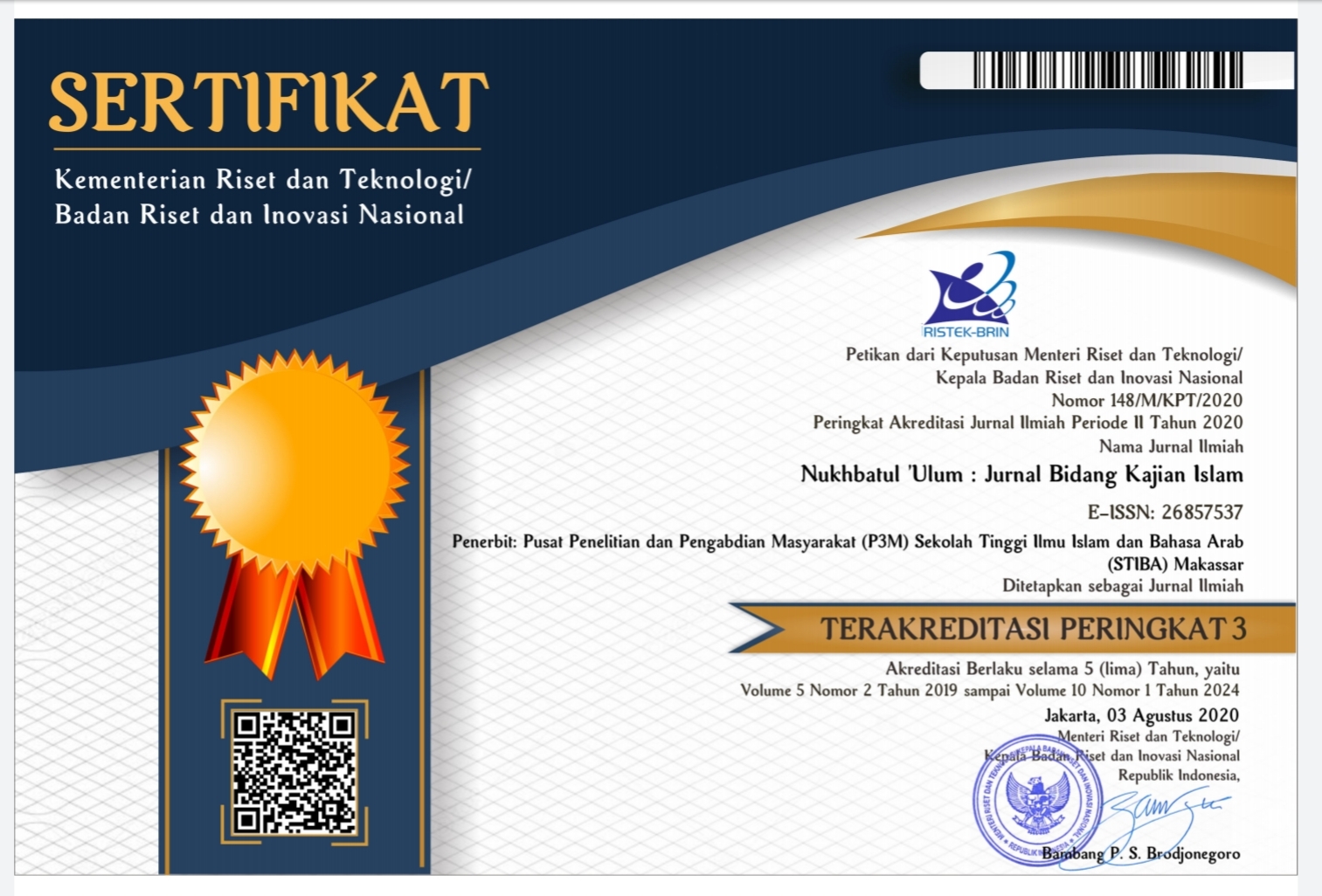Maskulinitas dan Feminitas dalam Al-Qur’an (Implikasi Sosial Atas Karakter Negatif)
Masculinity and Feminity in the Qur’an (Social Implication of Negative Character)
DOI:
https://doi.org/10.36701/nukhbah.v6i2.270Keywords:
Al-Qur'an, Masculinity, Femininity, Negative, Social ImplicationAbstract
This paper presents an argument that the negative feminine and masculine characters possessed by every human being harm social aspects. This argument was obtained because there was a paradigm shift from a traditionalist view to a new concept that was born in the 1970s. The traditionalist paradigm explicates that masculine and feminine characters are seen as contradicting the dimensions of the character's personality, attractiveness, and roles that differentiate men and women. On the other hand, a concept that was born starting in the 1970s emphasized the opposite. For instance, Alfred B. Heilburn categorized masculine and feminine characters as having positive and negative sides. It was also upheld by Sachiko Murata who exposed that both masculine and feminine characters exist in every human being and both have good and bad characters that are not limited to men and women. Uniquely, masculine and feminine concepts, as well as positive and negative characters, are also contained in the Qur’an. Therefore, the Qur’an frees humans to choose masculine or feminine characters as well as positive or negative characters to represent their personality. After tracing verses in the Qur’an about masculine and feminine, both positive and negative, the researcher found that masculine and feminine characters that were considered negative have detrimental implications for personal and social life. Based on this description, the paper tries to examine and explore these social impacts by using the thematic method of the Qur’an and analyzed by the theory proposed by Sachiko Murata.
Downloads
References
Al-Qur’ān al-Karīm..
AM, Rusydi. (2001). Perdagangan dalam Perspektif Al-Qur’an, (Disertasi Program Pascasarjana UIN Syarif Hidayatullah).
Al-Baghawī. (1990). Tafsīr al-Baghawī; Ma’ālim al-Tanzīl, jilid 6. Riyadh: Dār Ṭayyibah.
Al-Baiḍāwī. Anwār al-Tanzīl wa Asrār al-Ta’wīl, jilid 4. Dār Iḥyā al-Turāth al-‘Arabī.
Al-Zamakhsyari. (2009). Tafsīr al-Kasysyāf ‘an Ḥaqāiq al-Tanzīl wa ‘Uyūn li al-Aqāwīl fī Wujūh al-Ta’wīl (Vol.5). Beirut: Dār al-Ma’rifah.
Al-Zuhaili, Wahbah. (1998). al-Tafsīr al-Munīr fī al-‘aqīdah al-Syarī’ah wa al-Manhāj. Beirut: Dār al-Fikr al-Mu’āṣir.
Andika, Mayola. (2018). Reinterpretasi Ayat Gender dalam Memahami Relasi Laki-laki dan Perempuan (Sebuah Kajian Kontekstual dalam Penafsiran. Musawa, 17(2), 142.
Bem, Sandra L. (1974). The Measurement of Psychological Androgyny. Journal of Consulting and Clinical Psychology, 42(2).
Ciciek, Farha. (1999). Ikhtiar dalam Mengatasi Kekerasan dalam Rumah Tangga; Belajar dari Kehidupan Rasulullah saw. Jakarta: Lembaga Kajian Agama dan Gender.
Dacholfany, Ihsan. (2016). Dampak LGBT dan Antisipasinya di Masyarakat. Nizham 5(1), 110-111.
Febriani, Nur Arfiyah. (2014). Ekologi Berwawasan Gender dalam Perspektif Al-Qur’an. Bandung: Mizan Pustaka.
Fatwa Majelis Ulama Indonesia, no.3 tahun 2004 tentang Terorisme.
Frosh, Stephen. (2002). Sexual Difference: Masculinity and Psychoanalysis. New York: Taylor & Francis e-Library.
Ḥawwā, Sa’īd. (1999). al-Asās fī al-Tafsīr. Mesir: Dār al-Salām.
Hasyim, Syafiq. Ed. (1999). Menakar “Harga” Perempuan; Eksplorasi Lanjut atas Hak-hak Reproduksi Perempuan. Bandung: Mizan.
Heilbrun, Afred B. Jr. (1976). Measurement of Masculine and Feminine Sex Role Identities as Independent Dimension. Journal of Consulting and Clinical Psychology, 44(2), 183.
Hoffman, Rose Marie. (2001). Measurement of Masculiniy and Femininity: Historical Perpective and Implication for Counseling. Journal of Counseling and Development, 79, 472-476.
Howell, Nancy R. (1997). Ecofeminism: What One Needs to Know. Zygon, 32(2), 231-232.
Ibn Kaṡīr. (1999). Tafsīr al-Qur’ān al-‘Adhīm, jilid 3. Riyadh: Dār Ṭayyibah li al-Naṣr wa al-Tauzi’.
Jejen, Musfah. (2007). Indeks Al-Qur’an Praktis. Jakarta: Hikmah.
Jeglińska., Herman, Anna., Grabowska, Anna., & Dulko, Stanislaw. (2002). Masculinity , Femininity, and Transsexualism. Archives of Sexsual Behavior, 3(6), 529.
Kirkland, Russell. (2002). The History of Taoism: A New Outline. Journal of Chinese Religion, 30(1), 180.
Morawski, J G. (1985). The Measurement of Masculinity and Femininity: Engendering Categorical Realities. Durham: Duke University.
Muhanna, Aitemahad. (2015). Agency and Gender in Gaza: Masculinity and Family during the Second Intifada. Gender & History, 27(1), 234.
Mulia, Siti Musdah & Anwar, Marzani. Ed. (2001). Keadilan dan Kesetaraan Jender Perpektif Islam. Tim Pemberdayaan Perempuan Bidang Agama Departemen Agama RI.
Murata, Sachiko. (1992). The Tao of Islam; A Sourcebook on Gender Relationship in Islamic Thought. (Rahmani Astuti dan M.S Nasrullah). Bandung: Mizan.
Orlofsky, Jacob L. & Stake, Jayne E. (1981). Psychological Masculinity and Femininity: Relationship to Striving and Self-Concept in The Achievemen and Interpersonal Domains, Psychology of Women Quarterly, 6, 218.
Palan, Kay M., Areni, Charles S., & Kiecker, Pamela. (1999). Reexamining Masculinity, Femininity, and Gender Identity Scales, Marketing Letters, 10(4), 365.
Paechter, Carrie. Masculine Femininities/Feminine Masculinities: Power, Identities and Gender. Gender Education.
Al-Rāzī. Mafātīḥ al-Gaīb (Vol. 10). Beirut: Dār al-Fikr.
Shihab, M. Quraish. (2002). Tafsīr al-Miṣbāḥ; Pesan, Kesan dan Keserasian Al-Qur’an (Vol. 3). Jakarta: Lentera Hati.
¬¬________________. (2002). Tafsīr al-Miṣbāḥ; Pesan, Kesan dan Keserasian Al-Qur’an (Vol. 10). Jakarta: Lentera Hati.
________________. (2002). Tafsīr al-Miṣbāḥ; Pesan, Kesan dan Keserasian Al-Qur’an (Vol. 15). Jakarta: Lentera Hati.
Siddique, Kaukab. (2002). Menggugat “Tuhan yang Maskulin”. (Arif Maftuhin). Jakarta: Paramadina.
Spence, Janet T., Helmreich, Robert L., & Holahan, Carole K. (1979).Negative and Positive Components of Psychological Masculinity and Femininity and Their Relationships to Self-Reports of Neurotic and Acting Out Behaviors. Journal of Personality and Social Psychology, 37(10).
Spence, Janet T., Helmreich, Robert L., & Stapp, Joy. (1975). Rating of Self and Peers on Sex Role Attributes and Their Relation to Self-Esteem and Conceptions of Masculinity and Femininity. Journal of Personality and Sosial Psychology, 32(1), 29.
Suryorini, Ariana. (2012). Menelaah Feminisme dalam Islam. Sawwa, 7(2).
Umar, Nasaruddin. (1999). Kodrat Perempuan dalam Islam. Jakarta: Lembaga Kajian Agama dan Gender.
Weber, Max. (1951). The Religion of China; Confucianism and Taoism. Illinois: The Free Press.
Yang, Yingying & Merrill, Edward C. Cognitive and Pesonality Characteristics of Masculinity and Femininity Predict Wayfinding Competence and Strategies of Men and Woman. Sex Roles.


















